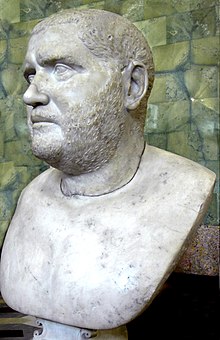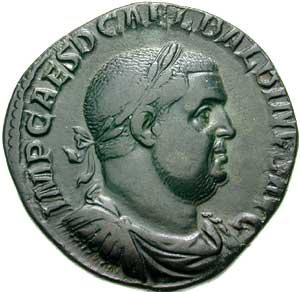| Balbinus | |||||||||
|---|---|---|---|---|---|---|---|---|---|
 Bust, Hermitage Museum Bust, Hermitage Museum | |||||||||
| Roman emperor | |||||||||
| Reign | April/May – July/August 238 | ||||||||
| Predecessor | Gordian I and II | ||||||||
| Successor | Gordian III | ||||||||
| Co-emperor | Pupienus | ||||||||
| Rival | Maximinus (until June) | ||||||||
| Born | c. 178 | ||||||||
| Died | 238 (aged approx. 60) Rome, Italy | ||||||||
| |||||||||
| Part of a series on Roman imperial dynasties |
| Year of the Six Emperors |
|---|
| AD 238 |
|
Decimus Caelius Calvinus Balbinus (died 238 AD) was Roman emperor with Pupienus for three months in 238, the Year of the Six Emperors.
Origins and career
Not much is known about Balbinus before his elevation to emperor. It has been conjectured that he descended from Publius Coelius Balbinus Vibullius Pius, the consul ordinarius of 137, and wife Aquilia. If this were true, he was also related to the family of Q. Pompeius Falco, which supplied many politicians of consular rank throughout the 3rd century, and to the 1st-century politician, engineer and author Julius Frontinus. He was born around 178. He was a patrician from birth, and was the son (either by birth or adoption) of Caelius Calvinus, who was legate of Cappadocia in 184. He was one of the Salii priests of Mars. According to Herodian he had governed provinces, but the list of seven provinces given in the unreliable Historia Augusta, as well as the statement that Balbinus had been both Proconsul of Asia and of Africa, are likely to be mere invention. He had certainly been twice consul; his first consulate is not certainly known but is believed to have been about 203 or in July 211; he was consul for the second time in 213 as colleague of Caracalla, which suggests he enjoyed that emperor's favour.
Reign
According to Edward Gibbon (drawing upon the narratives of Herodian and the Historia Augusta):
Balbinus was an admired orator, a poet of distinguished fame, and a wise magistrate, who had exercised with innocence and applause the civil jurisdiction in almost all the interior provinces of the empire. His birth was noble, his fortune affluent, his manners liberal and affable. In him, the love of pleasure was corrected by a sense of dignity, nor had the habits of ease deprived him of a capacity for business. (...) The two colleagues had both been consul (Balbinus had twice enjoyed that honourable office), both had been named among the twenty lieutenants of the senate; and, since the one was sixty and the other seventy-four years old, they had both attained the full maturity of age and experience.
On the news of the Gordians' defeat, the Senate voted Pupienus and Balbinus as co-emperors in April 238, though they were soon forced to co-opt the child Gordian III as a colleague. Unlike the situation in 161, both emperors were elected as pontifices maximi, chief priests of the official cults. This would be unthinkable in Republican times. Balbinus was probably in his early seventies: his qualifications for rule are unknown, except presumably that he was a senior senator, rich and well-connected. While Pupienus marched to Ravenna, where he oversaw the campaign against Maximinus, Balbinus remained in Rome, but failed to keep public order. The sources suggest that after Pupienus's victorious return following Maximinus' death, Balbinus and Pupienus began to distrust each other. They were soon assassinated by disaffected elements of the Praetorian Guard; Pupienus attempted to warn Balbinus of the plot, but the latter thought that the guard would instead secure the throne for himself.
Sarcophagus
The 'sarcophagus of Balbinus' has earned this Emperor a niche in the history of Roman Imperial art. Presumably while holding the title of Emperor, Balbinus had a marble sarcophagus made for himself and his wife (whose name is unknown). Discovered in fragments near the Via Appia and restored, this is the only example of a Roman Imperial sarcophagus of this type to have survived. On the lid are reclining figures of Balbinus and his wife, the figure of the Emperor also being a fine portrait of him. The sarcophagus is held in collection at the Museo di Pretastato (at the catacombs of Praetextatus) in the Park of the Caffarella near the Appian Way at Rome.
Although in accounts of their joint reign Balbinus is emphasized as the civilian as against Pupienus the military man, on the side of the sarcophagus he is portrayed in full military dress.
Family tree
| Maximinus Thrax Roman Emperor 235-238 | Gordian I Roman Emperor 238 | Pupienus Roman Emperor 238 | Philip the Arab Roman Emperor 244-249 | ||||||||||||||||||||||||||||||||||
| Gaius Julius Verus Maximus caesar | Gordian II co-emperor 238 | Antonia Gordiana | Balbinus Roman Emperor 238 | Philip II co-emperor 247-249 | |||||||||||||||||||||||||||||||||
| Gordian III Roman Emperor 238-244 | |||||||||||||||||||||||||||||||||||||
Gallery
-
 Portrait of the Roman Emperor Balbinus, dated AD 200–300, from the collection of the Cleveland Museum of Art.
Portrait of the Roman Emperor Balbinus, dated AD 200–300, from the collection of the Cleveland Museum of Art.
-
 Sestertius of Balbinus. Inscription: IMP. CAES. D. CAEL. BALBINVS AVG.
Sestertius of Balbinus. Inscription: IMP. CAES. D. CAEL. BALBINVS AVG.
-
 Statue of Balbinus, Archaeological Museum of Piraeus, Greece.
Statue of Balbinus, Archaeological Museum of Piraeus, Greece.
References
- For length stimations see: Rea, J.R. (1972). "O. Leid. 144 and the Chronology of A.D. 238". ZPE 9, 1–19. No contemporary or later sources give any definitive conclusion.
- Zonaras (c. 1120) Epitome xvii.17. " Maximus was seventy-four years old, Albinus sixty. According to some they reigned about twenty-two days , but according to others not quite three months."
- Cooley, Alison E. (2012). The Cambridge Manual of Latin Epigraphy. Cambridge University Press. p. 497. ISBN 978-0-521-84026-2.
- ^ Adkins, Lesley; Adkins, Roy A. (1994). Handbook to Life in Ancient Rome. New York: Oxford University Press. p. 26.
- Michael Grant,The Roman Emperors
- Gibbon, Edward; Milman, Henry Hart (7 June 2008). Widger, David (ed.). The History of the Decline and Fall of the Roman EmpireTable of Contents with links in the HTML file to the two Project Gutenberg editions (12 volumes). Vol. I. p. 225.
- Christer Bruun, J. C. Edmondson (2015). The Oxford Handbook of Roman Epigraphy. Oxford University Press. p. 191. ISBN 978-0-19-533646-7.
- HA, Life of Maximus and Balbinus; Herodian 8.8.4
External links
- portrait head from the sarcophagus as an example of Roman 'pathetic' style
- Livius.org: Balbinus (last accessed 22 September 2020)
| Regnal titles | ||
|---|---|---|
| Preceded byGordian I, Gordian II Maximinus Thrax |
Roman emperor 238 With: Pupienus |
Succeeded byGordian III |
| Political offices | ||
| Preceded by(Gn. Claudius ?) Severanus (Tib. Claudius ?) Pompeianus |
Roman consul 213 with Caracalla |
Succeeded byL. Valerius Messalla Apollinaris C. Octavius Appius Suetrius Sabinus |
| Pharaohs | |||||||||||||||||||||||||||||||||||||||
|---|---|---|---|---|---|---|---|---|---|---|---|---|---|---|---|---|---|---|---|---|---|---|---|---|---|---|---|---|---|---|---|---|---|---|---|---|---|---|---|
| |||||||||||||||||||||||||||||||||||||||
| |||||||||||||||||||||||||||||||||||||||
| |||||||||||||||||||||||||||||||||||||||
| |||||||||||||||||||||||||||||||||||||||
| |||||||||||||||||||||||||||||||||||||||
| List of pharaohs | |||||||||||||||||||||||||||||||||||||||